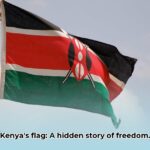Have you ever wondered about the stories behind the flags waving across Central America? These vibrant emblems are more than just colorful designs; they represent rich histories, diverse cultures, and unique national identities. While many share a common blue-white-blue design, a visual echo of a shared past, each flag tells its own distinct story. For a broader look at African flags, see this helpful resource. Join us on a colorful journey to uncover the hidden meanings and symbolism woven into these national banners.
Unveiling Central American Flags: A Tapestry of History and Symbolism
Central America’s flags serve as windows into the region’s complex past. The recurring blue, white, and blue triband sparks curiosity: what is the origin of this design, and how does each flag uniquely represent its nation? Let’s delve into the stories behind these national symbols, revealing the evolution of Central American flag designs.
The Enduring Legacy of a Shared Heritage: The Blue, White, and Blue Story
The shared blue-white-blue design is no mere coincidence. It represents the Federal Republic of Central America, a union formed in the 1800s. These colors symbolize the Pacific and Atlantic oceans (the blue) embracing the Central American isthmus (the white), signifying unity and a shared regional identity. However, the interpretations can be complex, and are even debated by historians. Central American flags are steeped in symbolism.
Decoding the Details: Each Flag’s Unique Narrative
While many flags build upon the blue-white-blue triband, they express their own national narrative. Let’s explore some variations to unlock the secrets of interpreting the symbolism embedded in Central American flags:
| Country | Flag | History & Adoption | Symbolism | Unique Features & Significance |
|---|---|---|---|---|
| Guatemala | [Insert Image of Guatemalan Flag] | Adopted post-independence, reflecting historical ties to the Federal Republic. | Blue: Pacific and Atlantic Oceans; White: land between the oceans; Coat of arms: Guatemalan identity & history. | Intricate coat of arms featuring the Resplendent Quetzal, a symbol of liberty, and a scroll commemorating independence. |
| El Salvador | [Insert Image of El Salvadoran Flag] | Origins trace back to the Federal Republic. | Blue: oceans; White: peace and solidarity. | Features the coat of arms encircled by the words “República de El Salvador en América Central.” |
| Honduras | [Insert Image of Honduran Flag] | Evolved from the Federal Republic flag. | Blue: oceans; White: peace and purity; Five stars: representing the five original Central American provinces. | Five stars arranged in an “X” pattern, a distinctive feature. |
| Nicaragua | [Insert Image of Nicaraguan Flag] | Reflects national identity post-independence. | Blue: oceans; White: purity; Coat of arms: symbolizes Nicaragua’s history and geography. | The coat of arms includes a rainbow, a Phrygian cap, and five volcanoes. |
| Costa Rica | [Insert Image of Costa Rican Flag] | A departure from the pure blue-white-blue. | Blue: sky, opportunity, perseverance; White: peace, wisdom, happiness; Red: warmth, courage, patriotism. | The horizontal red stripe, wider than the others, sets it apart. |
| Panama | [Insert Image of Panamanian Flag] | Established post-independence. | Red: Liberal Party; Blue: Conservative Party; White: peace and purity. | Two five-pointed stars, one red and one blue, in opposite corners. |
| Belize | [Insert Image of Belizean Flag] | Reflects Belize’s unique colonial history and distinct identity. | Blue: United Democratic Party; Red: People’s United Party; Coat of Arms: Belize’s history and resources. | Features two woodcutters of different ethnic backgrounds flanking a mahogany tree. |
Unpacking Symbolism: Beyond Literal Meanings
Interpreting flag symbolism isn’t always straightforward. The meanings of colors and emblems can vary based on historical context and cultural interpretation. For instance, the meaning of the five stars on the Honduran flag is debated, highlighting the multifaceted nature of national identity. A large majority of Central American flags incorporate the blue-white-blue motif, but each does so with unique modifications.
Flags: A Glimpse into Central American History
These flags provide a tangible connection to a rich and often turbulent history. They demonstrate the evolution of national identity, the impact of past events, and the pursuit of regional belonging. Each flag holds a story waiting to be uncovered, and ongoing research constantly evolves our understanding. The study of flags and their symbolism is a continuous journey.
Decoding Symbolism: A Practical Guide
Key Takeaways:
- Central American flags share a regional history but distinctly reflect unique national identities.
- Recurring color symbolism (blue, white, red) and design elements suggest shared historical experiences.
- Unique emblems tell individual national stories, reflecting diverse cultural identities.
Unraveling the Blue, White, and Red: A Shared Foundation
The blue-white-blue vertical triband echoes the flag of the Federal Republic of Central America (1823-1841). Blue often represents the Pacific and Atlantic oceans, while white symbolizes peace and unity. However, the full story is more complex.
Beyond the Triband: National Distinctions
Each nation adds its unique personal touch:
- Guatemala: Retains the blue and white, and incorporates a quetzal bird, symbolizing freedom.
- Honduras: Emphasizes the connection to the region with five stars, each representing one of the five original Central American nations.
- El Salvador: Features a national coat of arms emphasizing “God, Union, Liberty.”
- Nicaragua: Includes a coat of arms with a triangle, symbolizing equality, liberty, and fraternity.
- Costa Rica: Retains blue and white, adding a distinct red stripe to its design.
- Panama: Utilizes a unique design, diverging from the triband and incorporating stars to represent political parties and purity.
- Belize: The only Central American country with the Union Jack in its flag, represents its unique colonial history.
Deeper Meanings and Variations
Interpreting these symbols requires acknowledging nuanced perspectives. While the general meaning of colors is often accepted, specific shades and emblem details can spark debate. It’s crucial to consult multiple sources and critically evaluate the different interpretations.
Flags as Reflections of National Identity
Examining these flags reveals both shared history and individual identities. They reflect the past struggles and the vibrant future aspirations of each nation.
Comparative Analysis: Evolution of Flag Designs
Key Takeaways:
- Similarities stem from the legacy of the Federal Republic of Central America.
- The FRCA flag significantly influenced the region’s current flags.
- The contemporary flags now symbolize shared heritage and national divergence.
A Shared Legacy: Horizontal Blue and White
The dominant blue and white stripes in Central American flags are directly linked to the Federal Republic of Central America (FRCA), established in 1823. The FRCA left a lasting impact on Central American identity, and its flag became a powerful visual anchor. The blue color is often perceived to symbolize the sky and the sea, while white symbolizes peace and purity.
Variations: National Identity in Design
Each country expresses its unique national identity through subtle but important differences, such as distinctive national emblems and variations in the shades of blue.
Examining Individual Flags
Each flag possesses unique characteristics, yet retains elements showcasing shared ancestry and national variations, contributing to the rich tapestry of Central American flag symbolism:
| Country | Flag | Notable Features |
|---|---|---|
| Guatemala | [Insert Image of Guatemalan Flag] | Prominent central Coat of Arms, representing national history and cultural symbols. |
| Honduras | [Insert Image of Honduran Flag] | Five stars clustered in the center. |
| El Salvador | [Insert Image of El Salvadoran Flag] | Centered Coat of Arms with the motto “Dios, Unión, Libertad” (God, Union, Liberty). |
| Nicaragua | [Insert Image of Nicaraguan Flag] | Coat of Arms displaying a rainbow and five volcanoes. |
| Costa Rica | [Insert Image of Costa Rican Flag] | Horizontal stripes with a wider red stripe in the center and often displayed with its coat of arms. |
| Panama | [Insert Image of Panamanian Flag] | Unique design with quarters of red, white, and blue, each containing a star. |
| Belize | [Insert Image of Belizean Flag] | Surrounded by a red border with the countries coat of arms centered. |
Conclusion: A Shared Past, Distinct Futures
The presence of the blue and white triband highlights a shared historical experience, while national variations emphasize each nation’s distinct identity and aspirations.
Exploring Central American Flag Symbolism: Regional Variations and National Identities
Key Takeaways:
- Flags display shared historical roots while championing unique national identities.
*















